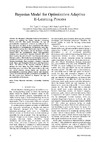Please use this identifier to cite or link to this item:
https://accedacris.ulpgc.es/handle/10553/73956
| DC Field | Value | Language |
|---|---|---|
| dc.contributor.author | Tapia, Francisco | en_US |
| dc.contributor.author | Lopez, C. A. | en_US |
| dc.contributor.author | Galan, M. J. | en_US |
| dc.contributor.author | Rubio Royo, Enrique | en_US |
| dc.date.accessioned | 2020-08-05T09:12:32Z | - |
| dc.date.available | 2020-08-05T09:12:32Z | - |
| dc.date.issued | 2008 | en_US |
| dc.identifier.issn | 1868-8799 | en_US |
| dc.identifier.other | Scopus | - |
| dc.identifier.other | WoS | - |
| dc.identifier.uri | https://accedacris.ulpgc.es/handle/10553/73956 | - |
| dc.description.abstract | In this paper, a Bayesian-Network-based model is proposed to optimize the Global Adaptive e-Learning Process (GAeLP). This model determines the type of personalization required for a learner according to his or her real needs, in which we have considered both objects and objectives of personalization. Furthermore, cause-andeffect relations among these objects and objectives with the learning phases, the learner, and the Intelligent Tutorial System (ITS) are accomplished. These cause-and-effect relations were coded into a Bayesian Network (BN), such that it involves the entire GAeLP. Four fundamental phases that have a direct effect in the learner's learning process are considered: Learner's previous knowledge Phase, Learner's Progress Knowledge Phase, Learner's /Teacher's Aims and Goals Phase, and Navigation Preferences and Experiences Phase. The efficacy of the Bayesian networks is proven through the first phase, in which learners of different knowledge area were select. The main results in this work are: causal relations among objects and objectives of personalization, knowledge phases, learner and electronic system. Personalization profiles set and their probabilities in the first phase were obtained to diagnose the type of personalization of the learner. | en_US |
| dc.language | eng | en_US |
| dc.relation.ispartof | International Journal of Emerging Technologies in Learning | en_US |
| dc.source | International Journal of Emerging Technologies in Learning [ISSN 1868-8799], v. 3 (2), p. 38-52, (Diciembre 2008) | en_US |
| dc.subject | 33 Ciencias tecnológicas | en_US |
| dc.subject.other | Bayesian Networks | en_US |
| dc.subject.other | E-Learning | en_US |
| dc.subject.other | Learning Metrics | en_US |
| dc.title | Bayesian model for optimization adaptive e-learning process | en_US |
| dc.type | info:eu-repo/semantics/Article | en_US |
| dc.type | Article | en_US |
| dc.identifier.scopus | 84862981345 | - |
| dc.identifier.isi | 000215426300006 | - |
| dc.contributor.authorscopusid | 55266091100 | - |
| dc.contributor.authorscopusid | 57212937730 | - |
| dc.contributor.authorscopusid | 15924912300 | - |
| dc.contributor.authorscopusid | 7101626071 | - |
| dc.identifier.eissn | 1863-0383 | - |
| dc.description.lastpage | 52 | en_US |
| dc.identifier.issue | 2 | - |
| dc.description.firstpage | 38 | en_US |
| dc.relation.volume | 3 | en_US |
| dc.investigacion | Ingeniería y Arquitectura | en_US |
| dc.type2 | Artículo | en_US |
| dc.contributor.daisngid | 32087870 | - |
| dc.contributor.daisngid | 12519627 | - |
| dc.contributor.daisngid | 32217737 | - |
| dc.contributor.daisngid | 8386397 | - |
| dc.description.numberofpages | 15 | en_US |
| dc.utils.revision | Sí | en_US |
| dc.contributor.wosstandard | WOS:Tapia, FJ | - |
| dc.contributor.wosstandard | WOS:Lopez, CA | - |
| dc.contributor.wosstandard | WOS:Galan, MJ | - |
| dc.contributor.wosstandard | WOS:Rubio, E | - |
| dc.date.coverdate | Diciembre 2008 | en_US |
| dc.identifier.ulpgc | Sí | es |
| dc.description.esci | ESCI | |
| item.grantfulltext | open | - |
| item.fulltext | Con texto completo | - |
| crisitem.author.dept | GIR IUCTC: Centro de Innovación para la Sociedad de la Información | - |
| crisitem.author.dept | IU de Cibernética, Empresa y Sociedad (IUCES) | - |
| crisitem.author.parentorg | IU de Cibernética, Empresa y Sociedad (IUCES) | - |
| crisitem.author.fullName | Rubio Royo,Enrique | - |
| Appears in Collections: | Artículos | |
SCOPUSTM
Citations
5
checked on Jun 8, 2025
WEB OF SCIENCETM
Citations
3
checked on Feb 25, 2024
Page view(s)
89
checked on Feb 1, 2025
Download(s)
102
checked on Feb 1, 2025
Google ScholarTM
Check
Share
Export metadata
Items in accedaCRIS are protected by copyright, with all rights reserved, unless otherwise indicated.
